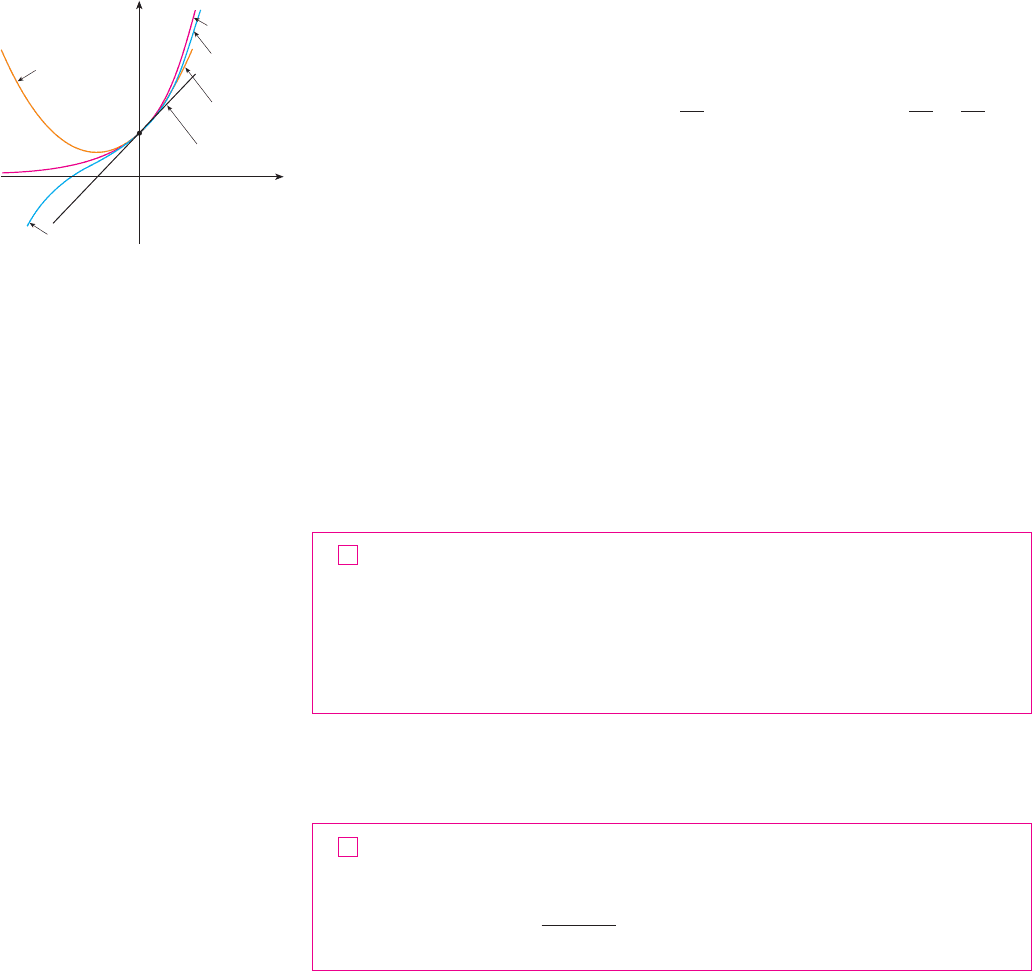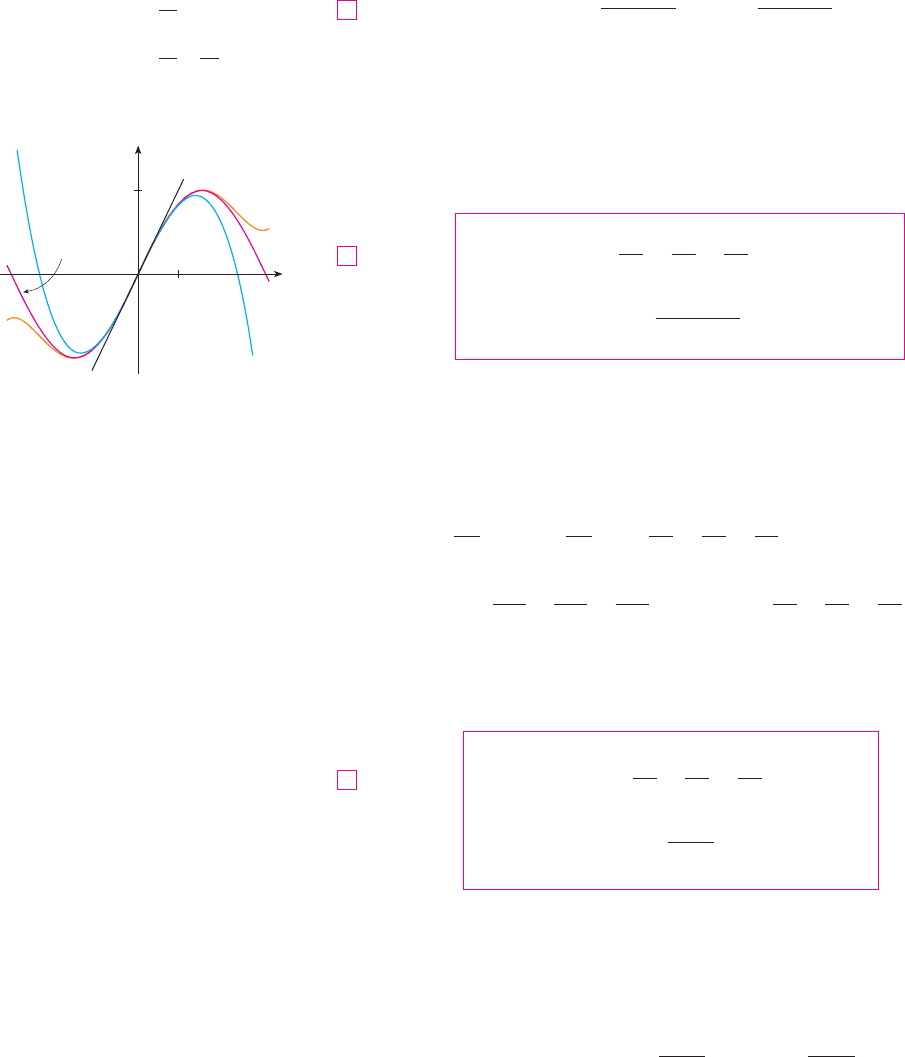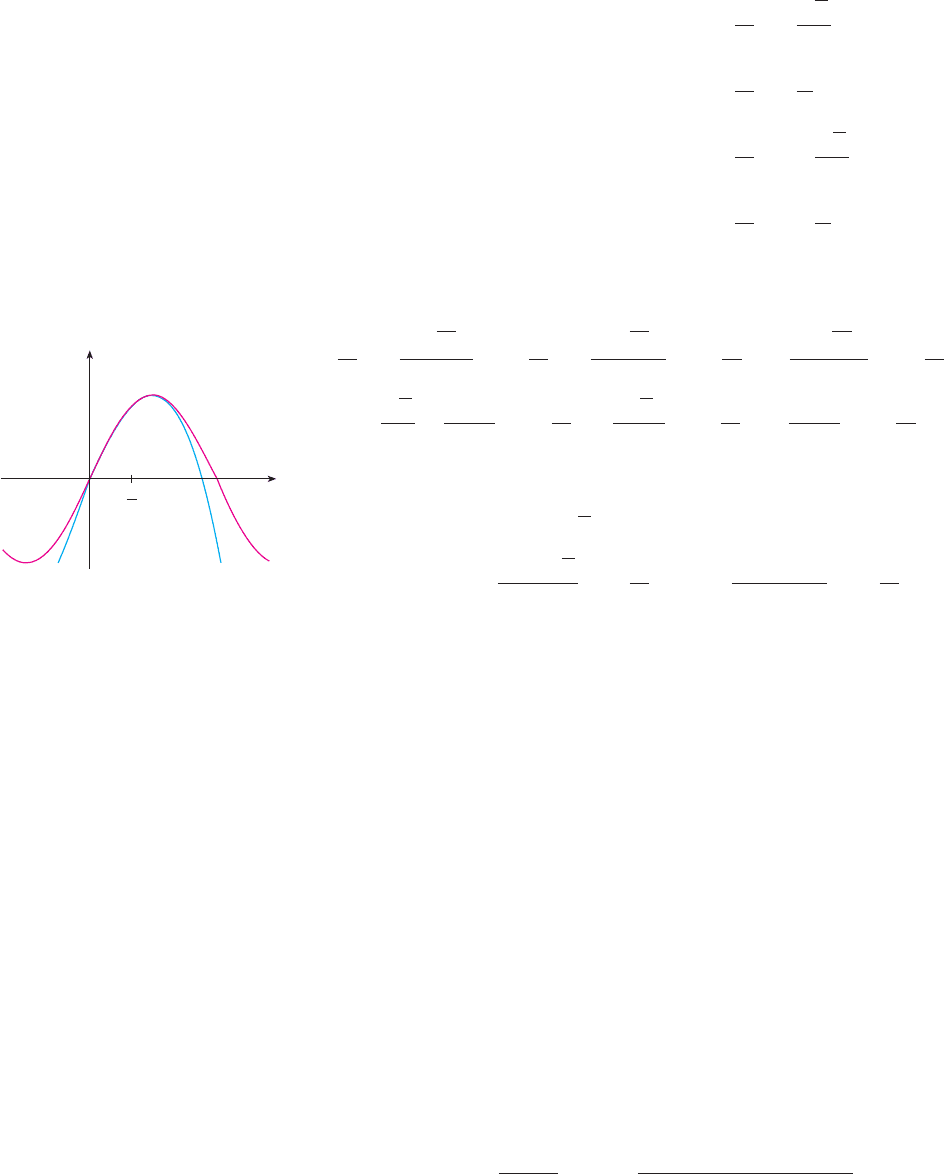Stewart J. Calculus
Подождите немного. Документ загружается.


The series in Equation 6 is called the Taylor series of the function f at a (or about a
or centered at a). For the special case the Taylor series becomes
This case arises frequently enough that it is given the special name Maclaurin series.
We have shown that if can be represented as a power series about , then is
equal to the sum of its Taylor series. But there exist functions that are not equal to the sum
of their Taylor series. An example of such a function is given in Exercise 70.
EXAMPLE 1 Find the Maclaurin series of the function and its radius of
convergence.
SOLUTION If , then , so for all . Therefore the
Taylor series for at 0 (that is, the Maclaurin series) is
To find the radius of convergence we let . Then
so, by the Ratio Test, the series converges for all and the radius of convergence
is .
M
The conclusion we can draw from Theorem 5 and Example 1 is that if has a power
series expansion at 0, then
So how can we determine whether does have a power series representation?
Let’s investigate the more general question: Under what circumstances is a function
equal to the sum of its Taylor series? In other words, if has derivatives of all orders, when
is it true that
As with any convergent series, this means that is the limit of the sequence of partial
sums. In the case of the Taylor series, the partial sums are
! f "a# $
f '"a#
1!
"x # a# $
f &"a#
2!
"x # a#
2
$ ( ( ( $
f
"n#
"a#
n!
"x # a#
n
T
n
"x# !
!
n
i!0
f
"i#
"a#
i!
"x # a#
i
f "x#
f "x# !
!
"
n!0
f
"n#
"a#
n!
"x # a#
n
f
e
x
e
x
!
!
"
n!0
x
n
n!
e
x
R ! "
x
)
a
n$1
a
n
)
!
)
x
n$1
"n $ 1#!
!
n!
x
n
)
!
'
x
'
n $ 1
l 0
%
1
a
n
! x
n
&n!
!
"
n!0
f
"n#
"0#
n!
x
n
!
!
"
n!0
x
n
n!
! 1 $
x
1!
$
x
2
2!
$
x
3
3!
$ ( ( (
f
nf
"n#
"0# ! e
0
! 1f
"n#
"x# ! e
x
f "x# ! e
x
f "x# ! e
x
V
faf
NOTE
f "x# !
!
"
n!0
f
"n#
"0#
n!
x
n
! f "0# $
f '"0#
1!
x $
f &"0#
2!
x
2
$ ( ( (
7
a ! 0
772
|| ||
CHAPTER 12 INFINITE SEQUENCES AND SERIES
The Taylor series is named after the English
mathematician Brook Taylor (1685–1731) and the
Maclaurin series is named in honor of the Scot-
tish mathematician Colin Maclaurin (1698–1746)
despite the fact that the Maclaurin series is
really just a special case of the Taylor series. But
the idea of representing particular functions as
sums of power series goes back to Newton, and
the general Taylor series was known to the Scot-
tish mathematician James Gregory in 1668 and
to the Swiss mathematician John Bernoulli in
the 1690s. Taylor was apparently unaware of the
work of Gregory and Bernoulli when he published
his discoveries on series in 1715 in his book
Methodus incrementorum directa et inversa
.
Maclaurin series are named after Colin Maclau-
rin because he popularized them in his calculus
textbook
Treatise of Fluxions
published in 1742.
TAYLOR A ND M ACLAURI N

Notice that is a polynomial of degree called the nth-degree Taylor polynomial of f
at a. For instance, for the exponential function , the result of Example 1 shows
that the Taylor polynomials at 0 (or Maclaurin polynomials) with , 2, and 3 are
The graphs of the exponential function and these three Taylor polynomials are drawn in
Figure 1.
In general, is the sum of its Taylor series if
If we let
so that
then is called the remainder of the Taylor series. If we can somehow show that
, then it follows that
We have therefore proved the following.
THEOREM If , where is the nth-degree Taylor polyno-
mial of at and
for , then is equal to the sum of its Taylor series on the interval
.
In trying to show that for a specific function , we usually use the
following fact.
TAYLOR’S INEQUALITY If for , then the remainder
of the Taylor series satisfies the inequality
To see why this is true for n ! 1, we assume that . In particular, we have
, so for we have
An antiderivative of is , so by Part 2 of the Fundamental Theorem of Calculus, we
have
f '"x# * f '"a# $ M"x # a#orf '"x# # f '"a# * M"x # a#
f 'f &
y
x
a
f &"t# dt *
y
x
a
M dt
a * x * a $ df &"x# * M
'
f &"x#
'
* M
for
'
x # a
'
* d
'
R
n
"x#
'
*
M
"n $ 1#!
'
x # a
'
n$1
R
n
"x#
'
x # a
'
* d
'
f
"n$1#
"x#
'
* M
9
flim
n l "
R
n
"x# ! 0
'
x # a
'
%
R
f
'
x # a
'
%
R
lim
n l "
R
n
"x# ! 0
af
T
n
f "x# ! T
n
"x# $ R
n
"x#
8
lim
n l "
T
n
"x# ! lim
n l "
* f "x# # R
n
"x#+ ! f "x# # lim
n l "
R
n
"x# ! f "x#
lim
n l "
R
n
"x# ! 0
R
n
"x#
f "x# ! T
n
"x# $ R
n
"x#R
n
"x# ! f "x# # T
n
"x#
f "x# ! lim
n l "
T
n
"x#
f "x#
T
3
"x# ! 1 $ x $
x
2
2!
$
x
3
3!
T
2
"x# ! 1 $ x $
x
2
2!
T
1
"x# ! 1 $ x
n ! 1
f "x# ! e
x
nT
n
SECTION 12.10 TAYLOR AND MACLAURIN SERIES
|| ||
773
0
x
y
y=´
y=T£(x)
(0,1)
y=T™(x)
y=T¡(x)
y=T™(x)
y=T£(x)
FIG URE 1
N As increases, appears to approach
in Figure 1. This suggests that is equal to the
sum of its Taylor series.
e
x
e
x
T
n
"x#n

Thus
But . So
A similar argument, using , shows that
So
Although we have assumed that , similar calculations show that this inequality is
also true for .
This proves Taylor’s Inequality for the case where . The result for any n is proved
in a similar way by integrating times. (See Exercise 69 for the case .)
In Section 12.11 we will explore the use of Taylor’s Inequality in approxi-
mating functions. Our immediate use of it is in conjunction with Theorem 8.
In applying Theorems 8 and 9 it is often helpful to make use of the following fact.
for every real number x
This is true because we know from Example 1 that the series converges for all
and so its term approaches 0.
EXAMPLE 2 Prove that is equal to the sum of its Maclaurin series.
SOLUTION If , then for all n. If d is any positive number and
, then . So Taylor’s Inequality, with and ,
says that
for
Notice that the same constant works for every value of n. But, from Equa-
tion 10, we have
lim
n l "
e
d
"n $ 1#!
'
x
'
n$1
! e
d
lim
n l "
'
x
'
n$1
"n $ 1#!
! 0
M ! e
d
'
x
'
* d
'
R
n
"x#
'
*
e
d
"n $ 1#!
'
x
'
n$1
M ! e
d
a ! 0
'
f
"n$1#
"x#
'
! e
x
* e
d
'
x
'
* d
f
"n$1#
"x# ! e
x
f "x# ! e
x
e
x
V
nth
x
(
x
n
&n!
lim
n l "
x
n
n!
! 0
10
NOTE
n ! 2n $ 1
n ! 1
x
%
a
x + a
'
R
1
"x#
'
*
M
2
'
x # a
'
2
R
1
"x# , #
M
2
"x # a#
2
f &"x# , #M
R
1
"x# *
M
2
"x # a#
2
R
1
"x# ! f "x# # T
1
"x# ! f "x# # f "a# # f '"a#"x # a#
f "x# # f "a# # f '"a#"x # a# *
M
2
"x # a#
2
f "x# # f "a# * f '"a#"x # a# $ M
"x # a#
2
2
y
x
a
f '"t# dt *
y
x
a
* f '"a# $ M"t # a#+ dt
774
|| ||
CHAPTER 12 INFINITE SEQUENCES AND SERIES
N As alternatives to Taylor’s Inequality, we have
the following formulas for the remainder term. If
is continuous on an interval and ,
then
This is called the
integral form of the remainder
term
. Another formula, called
Lagrange’s form of
the remainder term
, states that there is a number
between and such that
This version is an extension of the Mean Value
Theorem (which is the case ).
Proofs of these formulas, together with dis-
cussions of how to use them to solve the exam-
ples of Sections 12.10 and 12.11, are given on the
website
www.stewartcalculus.com
Click on
Additional Topics
and then on
Formulas
for the Remainder Term in Taylor series.
n ! 0
R
n
"x# !
f
"n$1#
"z#
"n $ 1#!
"x # a#
n$1
axz
R
n
"x# !
1
n!
y
x
a
"x # t#
n
f
"n$1#
"t# dt
x " IIf
"n$1#

It follows from the Squeeze Theorem that and therefore
for all values of x. By Theorem 8, is equal to the sum of its
Maclaurin series, that is,
M
In particular, if we put in Equation 11, we obtain the following expression
for the number as a sum of an infinite series:
EXAMPLE 3 Find the Taylor series for at .
SOLUTION We have and so, putting in the definition of a Taylor series
(6), we get
Again it can be verified, as in Example 1, that the radius of convergence is . As in
Example 2 we can verify that , so
M
We have two power series expansions for , the Maclaurin series in Equation 11 and
the Taylor series in Equation 13. The first is better if we are interested in values of near
0 and the second is better if is near 2.
EXAMPLE 4 Find the Maclaurin series for and prove that it represents for all .
SOLUTION We arrange our computation in two columns as follows:
Since the derivatives repeat in a cycle of four, we can write the Maclaurin series as
follows:
! x #
x
3
3!
$
x
5
5!
#
x
7
7!
$ ( ( ( !
!
"
n!0
"#1#
n
x
2n$1
"2n $ 1#!
f "0# $
f '"0#
1!
x $
f &"0#
2!
x
2
$
f )"0#
3!
x
3
$ ( ( (
f
"4#
"x# ! sin x f
"4#
"0# ! 0
f )"x# ! #cos x f )"0# ! #1
f &"x# ! #sin x f &"0# ! 0
f '"x# ! cos x f '"0# ! 1
f "x# ! sin x f "0# ! 0
xsin xsin x
x
x
e
x
for all xe
x
!
!
"
n!0
e
2
n!
"x # 2#
n
13
lim
n l "
R
n
"x# ! 0
R ! "
!
"
n!0
f
"n#
"2#
n!
"x # 2#
n
!
!
"
n!0
e
2
n!
"x # 2#
n
a ! 2f
"n#
"2# ! e
2
a ! 2f "x# ! e
x
e !
!
"
n!0
1
n!
! 1 $
1
1!
$
1
2!
$
1
3!
$ ( ( (
12
e
x ! 1
for all xe
x
!
!
"
n!0
x
n
n!
11
e
x
lim
n l "
R
n
"x# ! 0
lim
n l "
'
R
n
"x#
'
! 0
SECTION 12.10 TAYLOR AND MACLAURIN SERIES
|| ||
775
N In 1748 Leonard Euler used Equation 12 to
find the value of correct to digits. In 2003
Shigeru Kondo, again using the series in (12),
computed to more than 50 billion decimal
places. The special techniques employed to
speed up the computation are explained on the
web page
numbers.computation.free.fr
e
23e

Since is or , we know that for all x. So we can
take in Taylor’s Inequality:
By Equation 10 the right side of this inequality approaches 0 as , so
by the Squeeze Theorem. It follows that as , so
is equal to the sum of its Maclaurin series by Theorem 8.
M
We state the result of Example 4 for future reference.
EXAMPLE 5 Find the Maclaurin series for .
SOLUTION We could proceed directly as in Example 4 but it’s easier to differentiate the
Maclaurin series for given by Equation 15:
Since the Maclaurin series for converges for all , Theorem 2 in Section 12.9 tells
us that the differentiated series for also converges for all . Thus
M
EXAMPLE 6 Find the Maclaurin series for the function .
SOLUTION Instead of computing derivatives and substituting in Equation 7, it’s easier to
multiply the series for (Equation 16) by :
M
EXAMPLE 7 Represent as the sum of its Taylor series centered at .
!
&3f "x# ! sin x
x cos x ! x
!
"
n!0
"#1#
n
x
2n
"2n#!
!
!
"
n!0
"#1#
n
x
2n$1
"2n#!
xcos x
f "x# ! x cos x
for all x !
!
"
n!0
"#1#
n
x
2n
"2n#!
cos x ! 1 #
x
2
2!
$
x
4
4!
#
x
6
6!
$ ( ( (
16
xcos x
xsin x
! 1 #
3x
2
3!
$
5x
4
5!
#
7x
6
7!
$ ( ( ( ! 1 #
x
2
2!
$
x
4
4!
#
x
6
6!
$ ( ( (
cos x !
d
dx
"sin x# !
d
dx
$
x #
x
3
3!
$
x
5
5!
#
x
7
7!
$ ( ( (
%
sin x
cos x
for all x !
!
"
n!0
"#1#
n
x
2n$1
"2n $ 1#!
sin x ! x #
x
3
3!
$
x
5
5!
#
x
7
7!
$ ( ( (
15
sin xn l "R
n
"x# l 0
'
R
n
"x#
'
l 0
n l "
'
R
n
"x#
'
*
M
"n $ 1#!
'
x
n$1
'
!
'
x
'
n$1
"n $ 1#!
14
M ! 1
'
f
"n$1#
"x#
'
* 1-cos x-sin xf
"n$1#
"x#
776
|| ||
CHAPTER 12 INFINITE SEQUENCES AND SERIES
FIG URE 2
0
x
y
1
1
y=sin x
T∞
T£
T¡
N Figure 2 shows the graph of together
with its Taylor (or Maclaurin) polynomials
Notice that, as increases, becomes a
better approximation to .sin x
T
n
"x#n
T
5
"x# ! x #
x
3
3!
$
x
5
5!
T
3
"x# ! x #
x
3
3!
T
1
"x# ! x
sin x
N The Maclaurin series for , , and
that we found in Examples 2, 4, and 5 were dis-
covered, using different methods, by Newton.
These equations are remarkable because they
say we know everything about each of these
functions if we know all its derivatives at the
single number 0.
cos xsin xe
x

SOLUTION Arranging our work in columns, we have
and this pattern repeats indefinitely. Therefore the Taylor series at is
The proof that this series represents for all is very similar to that in Example 4.
[Just replace by in (14).] We can write the series in sigma notation if we
separate the terms that contain :
M
The power series that we obtained by indirect methods in Examples 5 and 6 and in
Section 12.9 are indeed the Taylor or Maclaurin series of the given functions because
Theorem 5 asserts that, no matter how a power series representation
is obtained, it is always true that . In other words, the coefficients are
uniquely determined.
EXAMPLE 8 Find the Maclaurin series for , where is any real number.
SOLUTION Arranging our work in columns, we have
. .
. .
. .
Therefore the Maclaurin series of is
!
"
n!0
f
"n#
"0#
n!
x
n
!
!
"
n!0
k"k # 1# ( ( ( "k # n $ 1#
n!
x
n
f "x# ! "1 $ x#
k
f
"n#
"x# ! k"k # 1# ( ( ( "k # n $ 1#"1 $ x#
k#n
f
"n#
"0# ! k"k # 1# ( ( ( "k # n $ 1#
f )"x# ! k"k # 1#"k # 2#"1 $ x#
k#3
f )"0# ! k"k # 1#"k # 2#
f &"x# ! k"k # 1#"1 $ x#
k#2
f &"0# ! k"k # 1#
f '"x# ! k"1 $ x#
k#1
f '"0# ! k
f "x# ! "1 $ x#
k
f "0# ! 1
kf "x# ! "1 $ x#
k
c
n
! f
"n#
"a#&n!
f "x# !
(
c
n
"x # a#
n
sin x !
!
"
n!0
"#1#
n
s
3
2"2n#!
$
x #
!
3
%
2n
$
!
"
n!0
"#1#
n
2"2n $ 1#!
$
x #
!
3
%
2n$1
s
3
x #
!
&3x
xsin x
!
s
3
2
$
1
2 ! 1!
$
x #
!
3
%
#
s
3
2 ! 2!
$
x #
!
3
%
2
#
1
2 ! 3!
$
x #
!
3
%
3
$ ( ( (
f
$
!
3
%
$
f '
$
!
3
%
1!
$
x #
!
3
%
$
f &
$
!
3
%
2!
$
x #
!
3
%
2
$
f )
$
!
3
%
3!
$
x #
!
3
%
3
$ ( ( (
!
&3
f )
$
!
3
%
! #
1
2
f )"x# ! #cos x
f &
$
!
3
%
! #
s
3
2
f &"x# ! #sin x
f '
$
!
3
%
!
1
2
f '"x# ! cos x
f
$
!
3
%
!
s
3
2
f "x# ! sin x
SECTION 12.10 TAYLOR AND MACLAURIN SERIES
|| ||
777
0
x
y
π
3
y=sin x
T£
FIG URE 3
N We have obtained two different series repre-
sentations for , the Maclaurin series in
Example 4 and the Taylor series in Example 7. It
is best to use the Maclaurin series for values of
near 0 and the Taylor series for near .
Notice that the third Taylor polynomial in Fig-
ure 3 is a good approximation to near
but not as good near 0. Compare it with the third
Maclaurin polynomial in Figure 2, where the
opposite is true.
T
3
!
&3sin x
T
3
!
&3xx
sin x

This series is called the binomial series. If its th term is
Thus, by the Ratio Test, the binomial series converges if and diverges
if . M
The traditional notation for the coefficients in the binomial series is
and these numbers are called the binomial coefficients.
The following theorem states that is equal to the sum of its Maclaurin series.
It is possible to prove this by showing that the remainder term approaches 0, but that
turns out to be quite difficult. The proof outlined in Exercise 71 is much easier.
THE BINOMIAL SERIES If is any real number and , then
Although the binomial series always converges when , the question of whether
or not it converges at the endpoints, , depends on the value of . It turns out that the
series converges at 1 if and at both endpoints if . Notice that if is a
positive integer and , then the expression for contains a factor , so
for . This means that the series terminates and reduces to the ordinary Binomial
Theorem when is a positive integer. (See Reference Page 1.)
EXAMPLE 9 Find the Maclaurin series for the function and its radius
of convergence.
SOLUTION We write in a form where we can use the binomial series:
1
s
4 # x
!
1
,
4
$
1 #
x
4
%
!
1
2
,
1 #
x
4
!
1
2
$
1 #
x
4
%
#1&2
f "x#
f "x# !
1
s
4 # x
V
k
n + k
! 0
(
k
n
)
"k # k#
(
k
n
)
n + k
kk , 0#1
%
k * 0
k-1
'
x
'
%
1
"1 $ x#
k
!
!
"
n!0
$
k
n
%
x
n
! 1 $ kx $
k"k # 1#
2!
x
2
$
k"k # 1#"k # 2#
3!
x
3
$ ( ( (
'
x
'
%
1k
17
R
n
"x#
"1 $ x#
k
$
k
n
%
!
k"k # 1#"k # 2# ( ( ( "k # n $ 1#
n!
'
x
'
+ 1
'
x
'
%
1
!
'
k # n
'
n $ 1
'
x
'
!
)
1 #
k
n
)
1 $
1
n
'
x
'
l
'
x
'
as n l "
)
a
n$1
a
n
)
!
)
k"k # 1# ( ( ( "k # n $ 1#"k # n#x
n$1
"n $ 1#!
!
n!
k"k # 1# ( ( ( "k # n $ 1#x
n
)
a
n
, thenn
778
|| ||
CHAPTER 12 INFINITE SEQUENCES AND SERIES

Using the binomial series with and with replaced by , we have
We know from (17) that this series converges when , that is, , so the
radius of convergence is .
M
We collect in the following table, for future reference, some important Maclaurin series
that we have derived in this section and the preceding one.
One reason that Taylor series are important is that they enable us to integrate functions
that we couldn’t previously handle. In fact, in the introduction to this chapter we men-
tioned that Newton often integrated functions by first expressing them as power series and
then integrating the series term by term. The function can’t be integrated by
techniques discussed so far because its antiderivative is not an elementary function (see
Section 8.5). In the following example we use Newton’s idea to integrate this function.
f "x# ! e
#x
2
R ! 1"1 $ x#
k
!
!
"
n!0
$
k
n
%
x
n
! 1 $ kx $
k"k # 1#
2!
x
2
$
k"k # 1#"k # 2#
3!
x
3
$ ( ( (
R ! 1tan
#1
x !
!
"
n!0
"#1#
n
x
2n$1
2n $ 1
! x #
x
3
3
$
x
5
5
#
x
7
7
$ ( ( (
R ! "cos x !
!
"
n!0
"#1#
n
x
2n
"2n#!
! 1 #
x
2
2!
$
x
4
4!
#
x
6
6!
$ ( ( (
R ! "sin x !
!
"
n!0
"#1#
n
x
2n$1
"2n $ 1#!
! x #
x
3
3!
$
x
5
5!
#
x
7
7!
$ ( ( (
R ! "e
x
!
!
"
n!0
x
n
n!
! 1 $
x
1!
$
x
2
2!
$
x
3
3!
$ ( ( (
R ! 1
1
1 # x
!
!
"
n!0
x
n
! 1 $ x $ x
2
$ x
3
$ ( ( (
R ! 4
'
x
'
%
4
'
#x&4
'
%
1
!
1
2
-
1 $
1
8
x $
1 ! 3
2!8
2
x
2
$
1 ! 3 ! 5
3!8
3
x
3
$ ( ( ( $
1 ! 3 ! 5 ! ( ( ( ! "2n # 1#
n!8
n
x
n
$ ( ( (
.
$ ( ( ( $
(
#
1
2
)(
#
3
2
)(
#
5
2
)
( ( (
(
#
1
2
# n $ 1
)
n!
$
#
x
4
%
n
$ ( ( (
.
!
1
2
-
1 $
$
#
1
2
%$
#
x
4
%
$
(
#
1
2
)(
#
3
2
)
2!
$
#
x
4
%
2
$
(
#
1
2
)(
#
3
2
)(
#
5
2
)
3!
$
#
x
4
%
3
1
s
4 # x
!
1
2
$
1 #
x
4
%
#1&2
!
1
2
!
"
n!0
$
#
1
2
n
%$
#
x
4
%
n
#x&4xk ! #
1
2
SECTION 12.10 TAYLOR AND MACLAURIN SERIES
|| ||
779
TAB LE 1
Important Maclaurin Series and
Their Radii of Convergence
Module 12.10 /12.11 enables you
to see how successive Taylor polynomials
approach the original function.
TE C

EXAMPLE 10
(a) Evaluate as an infinite series.
(b) Evaluate correct to within an error of .
SOLUTION
(a) First we find the Maclaurin series for . Although it’s possible to use the
direct method, let’s find it simply by replacing with in the series for given in
Table 1. Thus, for all values of x,
Now we integrate term by term:
This series converges for all because the original series for converges for all .
(b) The Fundamental Theorem of Calculus gives
The Alternating Series Estimation Theorem shows that the error involved in this approxi-
mation is less than
M
Another use of Taylor series is illustrated in the next example. The limit could be found
with l’Hospital’s Rule, but instead we use a series.
EXAMPLE 11 Evaluate .
SOLUTION Using the Maclaurin series for , we have
because power series are continuous functions. M
! lim
x l 0
!
1
2
!
x
3!
!
x
2
4!
!
x
3
5!
! " " "
"
!
1
2
! lim
x l 0
x
2
2!
!
x
3
3!
!
x
4
4!
! " " "
x
2
lim
x l 0
e
x
# 1 # x
x
2
! lim
x l 0
!
1 !
x
1!
!
x
2
2!
!
x
3
3!
! " " "
"
# 1 # x
x
2
e
x
lim
x l 0
e
x
# 1 # x
x
2
1
11 ! 5!
!
1
1320
$
0.001
# 1 #
1
3
!
1
10
#
1
42
!
1
216
# 0.7475
! 1 #
1
3
!
1
10
#
1
42
!
1
216
# " " "
y
1
0
e
#x
2
dx !
$
x #
x
3
3 ! 1!
!
x
5
5 ! 2!
#
x
7
7 ! 3!
!
x
9
9 ! 4!
# " " "
%
0
1
xe
#x
2
x
! C ! x #
x
3
3 ! 1!
!
x
5
5 ! 2!
#
x
7
7 ! 3!
! " " " ! '
n
x
2n!1
&2n ! 1'n!
! " " "
y
e
#x
2
dx !
y
!
1 #
x
2
1!
!
x
4
2!
#
x
6
3!
! " " " ! '
n
x
2n
n!
! " " "
"
dx
e
#x
2
!
(
%
n!0
&#x
2
'
n
n!
!
(
%
n!0
'
n
x
2n
n!
! 1 #
x
2
1!
!
x
4
2!
#
x
6
3!
! " " "
e
x
#x
2
x
f &x' ! e
#x
2
0.001x
1
0
e
#x
2
dx
x e
#x
2
dx
V
780
|| ||
CHAPTER 12 INFINITE SEQUENCES AND SERIES
N We can take in the antiderivative
in part (a).
C ! 0
N Some computer algebra systems compute
limits in this way.

MULTIPLIC ATION AND DIVISION OF POWER SERIES
If power series are added or subtracted, they behave like polynomials (Theorem 12.2.8
shows this). In fact, as the following example illustrates, they can also be multiplied and
divided like polynomials. We find only the first few terms because the calculations for the
later terms become tedious and the initial terms are the most important ones.
EXAMPLE 12 Find the first three nonzero terms in the Maclaurin series for (a)
and (b) .
SOLUTION
(a) Using the Maclaurin series for and in Table 1, we have
We multiply these expressions, collecting like terms just as for polynomials:
Thus
(b) Using the Maclaurin series in Table 1, we have
We use a procedure like long division:
Thus
M
Although we have not attempted to justify the formal manipulations used in Exam-
ple 12, they are legitimate. There is a theorem which states that if both and
converge for and the series are multiplied as if they were polyno-
mials, then the resulting series also converges for and represents . For
division we require ; the resulting series converges for sufficiently small .
)
x
)
b
0
" 0
f &x't&x'
)
x
)
$
R
)
x
)
$
Rt&x' !
*
b
n
x
n
f &x' !
*
c
n
x
n
tan x ! x !
1
3
x
3
!
2
15
x
5
! " " "
tan x !
sin x
cos x
!
x #
x
3
3!
!
x
5
5!
# " " "
1 #
x
2
2!
!
x
4
4!
# " " "
e
x
sin x ! x ! x
2
!
1
3
x
3
! " " "
" " "!
1
3
x
3
!x
2
!x
" " "#
1
6
x
4
#
1
6
x
3
#!
" " "!
1
6
x
4
!
1
2
x
3
!x
2
!x
" " "!
1
6
x
3
#x&
" " "!
1
6
x
3
!
1
2
x
2
!x1 !
e
x
sin x !
!
1 !
x
1!
!
x
2
2!
!
x
3
3!
! " " "
"!
x #
x
3
3!
! " " "
"
sin xe
x
tan x
e
x
sin x
SECTION 12.10 TAYLOR AND MACLAURIN POLYNOMIALS
|| ||
781
2
15
x
5
! " " "
1
3
x
3
#
1
6
x
5
! " " "
1
3
x
3
#
1
30
x
5
! " " "
x #
1
2
x
3
!
1
24
x
5
# " " "
1 #
1
2
x
2
!
1
24
x
4
# " " "
)
x #
1
6
x
3
!
1
120
x
5
# " " "
x !
1
3
x
3
!
2
15
x
5
! " " "
